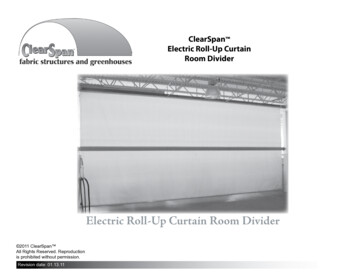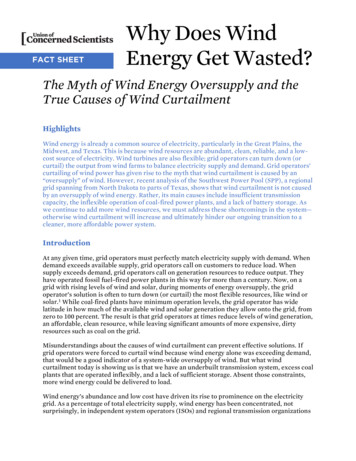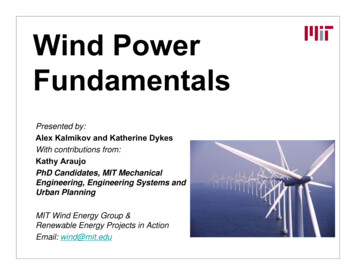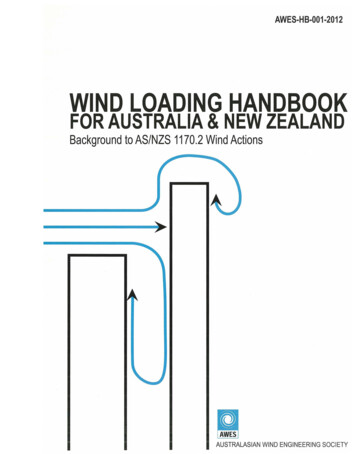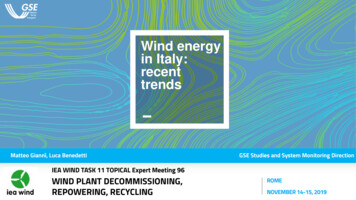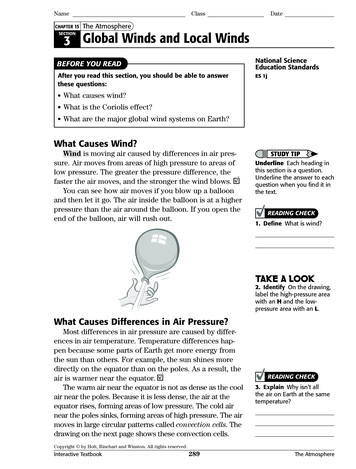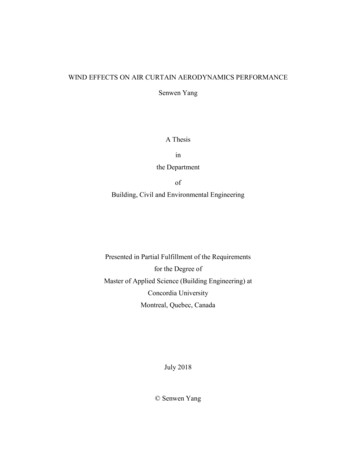
Transcription
WIND EFFECTS ON AIR CURTAIN AERODYNAMICS PERFORMANCESenwen YangA Thesisinthe DepartmentofBuilding, Civil and Environmental EngineeringPresented in Partial Fulfillment of the Requirementsfor the Degree ofMaster of Applied Science (Building Engineering) atConcordia UniversityMontreal, Quebec, CanadaJuly 2018 Senwen Yang
CONCORDIA UNIVERSITYSchool of Graduate StudiesThis is to certify that the thesis preparedBy:Senwen YangEntitled:Wind Effects on Air Curtain Aerodynamics Performanceand submitted in partial fulfillment of the requirements for the degree ofMaster of Applied Science (Building Engineering)complies with the regulations of the University and meets the accepted standards with respect tooriginality and quality.Signed by the final Examining Committee:Dr. S. LiChairDr. L. KademExaminerDr. H. GeExaminerDr. L. WangCo-SupervisorDr. T. StathopoulosCo-SupervisorApproved by:Chair of Department or Graduate Program DirectorDean of FacultyDate:2018II
ABSTRACTWind Effects on Air Curtain Aerodynamics PerformanceSenwen YangAir curtains are widely used in various building types to reduce infiltration and associated energylosses through building entrances. Quantifying the infiltration rate through a building entrance isdirectly related to the evaluation of the energy performance of air curtains. Consequently, manyprevious studies identify and measure the impacts of various factors on performance, includingdoor operation, usage frequency and air supply angle and velocity. However, to date limited studieshave focused on the effect of wind on air curtain performance, even though wind is commonlyconsidered to play an important role. The purpose of this research is to identify wind effects on theperformance of air curtains through an experimental study, taking into account parametersincluding wind speed and angle, air curtain supply flow speed and supply flow angle, and thepressure difference acting across an air curtain. The relation between air infiltration and thepressure difference across an air curtain with and without wind is analyzed. Experiments areconducted in a large chamber equipped with an air curtain and a corresponding sub-scaled modelin the wind tunnel. The results from differing wind speeds and air curtain supplies from bothexperiments are subsequently compared, and the wind effects in both cases are found to beconsistent. This study finds the following: when the air curtain jet is able to reach the floor, thusproviding a good sealing of the door, it can effectively resist the wind; a strong wind blowingdirectly towards the air curtain reduces its performance; and the performance is related to bothwind speed and wind incident angle.III
ACKNOWLEDGEMENTI would like to express my thanks and gratitude to my supervisors, Dr. Liangzhu (Leon) Wang andDr. Theodore Stathopoulos. Their supervision and advice have been important throughoutcompleting this research and thesis. I would like to appreciate their continuous guidance,suggestions and support for my study.Furthermore, I would like to express my appreciation to all of my colleagues in the group, Dr.Dahai Qi, Dr. Wael Fayrouz, Cheng Zhang and Hatem Alrawashdeh, who have given muchsupport and advice. In particular:Dr. Dahai Qi helped to develop the air curtain scale method and instruct the author start theexperiment.; Cheng Zhang assisted to with particle image velocimetry measurement dataprocessing; Hatem Alrawashdeh helped to install the experiment the model and instruct to operatethe devices in the Wind Tunnel; Dr. Wael Fairouz EzzEldin helped to install the particle imagevelocimetry devices, including the laser, camera, and traverse.It has also been a joyful experience to work with and learn from them.I also want to acknowledge the financial and technical support from the Air Management andControl Association (AMCA) and the valuable comments and advice from Mr. David Johnson atBerner International, Mr. Frank Cuaderno at Mars Air Systems, Mr. Brian Jones at Powered Aire,and Ms. Amanda Hickman at the Hickman Group.Finally, I would like to acknowledge the great support and encouragement of my family, withoutwhich it would have been impossible for me to have access to this study and complete the research.IV
I also want to thank my friends both in North America and China, as it has been very important tohave their encouragement and support while continuing my study.V
TABLE OF CONTENTSTABLE OF CONTENTS . VILIST OF FIGURES . IXLIST OF TABLES . XIINOMENCLATURE . XIII1.2.3.INTRODUCTION . 11.1Background . 11.2Experimental Tasks and Objectives . 31.2.1Experimental Study in Large-scale Chamber . 31.2.2Scaled Model Study in Wind Tunnel . 3LITERATURE REVIEW . 62.1Infiltration through Building Entrance. 62.2Air Curtains . 82.3Wind Engineering . 142.3.1Basics of wind engineering . 142.3.2Boundary Layer Wind Tunnel . 172.4Wind Effects on Air Curtains . 182.5Particle Image Velocimetry (PIV) . 202.6Conclusion . 23METHODOLOGY . 25VI
Large-scale Air Curtain Study . 253.13.1.13.24.Scaled Air Curtain Study in Wind Tunnel . 313.2.1Introduction . 313.2.2Experimental Design and Setup . 323.2.3Wind Speed and Wind Direction Settings . 39RESULTS AND DUSCUSSION . 414.1Large-scale experiment results . 414.1.1Air Curtain Overall Performance Tests . 414.1.2Comparative Tests for Wind Effects. 444.2Sub-scale Experiment Results. 484.2.1Wind Speed Effects. 484.2.2Wind Angle Effects. 604.2.3Effects of Person in the Doorway . 674.3Large-scale tests and Sub-scale tests: Result Comparison . 704.3.15.Experimental Design and Setup . 25Result Comparison between Different Scales. 70CONCLUSION AND FUTURE STUDY . 735.1Conclusions . 735.2Limitations of the Study. 745.3Recommendations for Future Work. 74VII
REFERENCES . 76APPENDIX (A) . 82Detailed Results in the Large-scale Chamber . 82APPENDIX (B) . 86Detailed Results from Wind Speed Effect Sub-Scale Tests in Wind Tunnel . 86APPENDIX (C) . 89Detailed Results from Wind Direction Effect Sub-Scale Tests in Wind Tunnel . 89APPENDIX (D) . 91Detailed Results from Person Effect Sub-Scale Tests in Wind Tunnel . 91APPENDIX (E) . 93Detailed Results Single Door and Vestibule Sub-Scale Tests in Wind Tunnel . 93VIII
LIST OF FIGURESFigure 1-1. Scaled model of the CUBE test chamber for the wind tunnel test. . 4Figure 2-1. Building entrance model with vestibule (Yuill, 1996) and single door. . 7Figure 2-2. 2D air curtain theoretical model. (Hayes, 1968) . 8Figure 2-3. Inside-installed and outside-installed air curtains (Hayes, and Stoecker, 1969). 10Figure 2-4. Infiltration and ex-filtration characteristics of air curtain doors in comparison to singleand vestibule doors at 100 Ph door usage (supply 15 m/s at 20 outwards) (Wang, 2013). . 11Figure 2-5. The three typical operation conditions of air curtains (Wang and Zhong, 2014). . 12Figure 2-6. Correlation of air curtain door infiltration at a door opening angle of 90 (Wang andZhong, 2014). . 13Figure 2-7. Experimental results and CFD simulations results for air curtains performance with jetsupply 9.1 /s, 20 outward and 13.75m/s, 20 outward. (Goubran, 2016). 14Figure 2-8. Empirical power laws over different terrains (Davenport, 1965). . 15Figure 2-9. A schematic view of the model subway tunnel (Juraeva et al., 2016). . 19Figure 2-10. 2D PIV system components and the data processing stream (“Laser Optical CCD andsCMOS Cameras Dantec Dynamics,” n.d.). . 21Figure 3-1. Concordia University Building Environment (CUBE) lab. . 26Figure 3-2. Schematic of wind generator and air curtain door. . 27Figure 3-3. Wind generator. . 28Figure 3-4. Internal vanes and external switches of the wind generator. . 28Figure 3-5. Measured velocity (m/s) distribution for the wind generator. 29Figure 3-6. View of sub-scale model in the wind tunnel. . 33Figure 3-7. Dimensions of sub-scale model (back view of the chamber). . 33IX
Figure 3-8. Connection of devices for experimental setup (top view of the chamber). . 34Figure 3-9. Side view of the experimental setup in the wind tunnel. . 35Figure 3-10. Schematic sketch of wind direction measurement (top view in wind tunnel) . 37Figure 3-11. Different wind angle tests (the incoming wind pointing outwards of the page). . 38Figure 3-12. PIV setup for capturing the air curtain flow pattern. . 39Figure 4-1. Air curtain performance for the air curtain (AC) supply speed of 13.75 m/s. . 42Figure 4-2. Air curtain performance for the air curtain supply speed of 9.1 m/s. . 43Figure 4-3. Comparative tests for wind effects for air curtains supply 1 and 2 (13.75 m/s), and thesingle door. . 45Figure 4-4. Comparative tests for wind effects for air curtain supply 3 and 4 (9.1 m/s). . 46Figure 4-5. Comparative tests for wind effects for air curtain supply 5.6 m/s and 0 angle. . 47Figure 4-6. Air curtain: supply speed 9.6 m/s and supply angle 0 (Note: the measured pressuredifferences here include the wind stagnation pressure). . 48Figure 4-7. (A1-A2-A3) PIV results without wind for the 0 , 9.6 m/s air curtain. . 50Figure 4-8. PIV results with 4 m/s outside wind for the 0 , 9.6 m/s air curtain. . 51Figure 4-9. PIV results with 10 m/s wind for the 0 , 9.6 m/s air curtain. . 52Figure 4-10. Air curtain: supply speed 9.6 m/s and supply angle 20 . 54Figure 4-11. (A1-A3) PIV results without wind for the 20 , 9.6 m/s air curtain. 55Figure 4-12. (B1-B3) PIV results with 4 m/s wind for the 20 , 9.6 m/s air curtain. . 56Figure 4-13. (C1-C3) PIV results with 10 m/s wind for the 20 , 9.6 m/s air curtain. . 57Figure 4-14. Air curtain: supply speed 5.6 m/s and supply angle 0 and 20 without wind and with10 m/s wind. . 59Figure 4-15. PIV results for the 0 and 5.6 m/s air curtain in no-wind condition. . 60X
Figure 4-16. Air curtain (9.6 m/s, 0 ) performance with 4 m/s wind at wind direction (β) differentand with the double swing door. . 61Figure 4-17. PIV results of the 3D flow streamlines of 10 m/s, 60 wind and 9.6 m/s and 0 aircurtain supply. . 62Figure 4-18. PIV results of the vertical central plane of the door with 10 m/s, 60 wind and 9.6 m/sand 0 air curtain supply. . 63Figure 4-19. PIV results of the horizontal plane flow field at 1 cm above the floor for 10 m/s, 60 wind and 9.6 m/s and 0 air curtain supply. 63Figure 4-20. Wind angle effect comparison with and without the door with 4 m/s wind for 9.6 m/s,0 air curtain supply. . 64Figure 4-21. PIV results of the 3D flow streams for 10 m/s, 60 wind and 9.6 m/s, 0 air curtainwithout the double swing door. . 65Figure 4-22. PIV results of the vertical central plane of the door for 10 m/s, 60 wind and 9.6 m/s,0 air curtain without the double swing door. . 66Figure 4-23. PIV results of the horizontal flow field at 1 cm above the floor for 10 m/s, 60 windand 9.6 m/s, 0 air curtain without the double swing door. . 66Figure 4-24. Air curtain supply 9.6 m/ and angle 0 with and without person in the doorway. . 67Figure 4-25. PIV results of the 4 m/s and 0 wind and the 9.6 m/s and 0 air curtain with a personunder the air curtain. . 68Figure 4-26. Air curtain supply 9.6 m/s and supply angle 20 with and without the person. . 69Figure 4-27. Sub-scale building model with a vestibule. 70Figure 4-28. Results of comparison among difference scales without the wind. . 71Figure 4-29. Results of comparison among different scales with the 4 m/s wind. . 72XI
LIST OF TABLESTable 1 Characteristic parameters in power law wind profile defined in wind loading code EN1991-1-4 (Geurts and Bentum, 2007). . 17Table 2 Seeding particles in gas flows (Melling, 1997). . 23Table 3. Wind generator calibration information. . 29Table 4. Test settings for the Air Curtain Overall Performance Tests. 30Table 5. Air curtain supply settings. . 41Table 6. Study of wind speed effects. . 40Table 7. Study of wind direction effects. . 40XII
NOMENCLATUREAArea, m2AdCross-sectional area of the duct connector, m2b0Width of the air curtain nozzle, mCAAirflow coefficientCdDischarge coefficientCDaveAverage discharge coefficient for each door operation sectionDD,aveDischarge modifier (air curtains)HDoor height, mQVolume flow rate, m3/sQeflow rate of the exhaust CPU fans, m3/sQjAir curtain jet flow rate, m3/sReReynolds numberThUsage per hour (doors), 1/hu0Air curtain discharge speed, m/sUmaxexpected maximum flow speed in the field, m/sVaveAverage speed in the connection duct, m/sVgVelocity at gradient height, m/sV(z)Velocity at a certain height, m/sZHeight of a certain point, mZGGradient height of different wind profiles, mXIII
GREEK LETTERSαpower law exponent for the specific terrain and exposureα0the discharge angle (supply angle) of the air curtain unit, degreeβWind direction, degreeΔP (or ΔPa)Pressure difference across the air curtain door due to the air curtain, Pa pfPressure difference caused by frictionΔtthe time delay between laser pulses, μsθAir curtain jet discharge angle, degreeρAir density, kg/m3ACRONYMSAir curtain doorDouble swing doors opening installed with air curtain unitAMCAAir Movement and Control Association (International)ASHRAEAmerican Society of Heating, Refrigerating and Air-ConditioningEngineersCFDComputational Fluid DynamicsCUBEConcordia University Built Environment labHVACHeating, ventilation, and air conditioningPIVParticle Image VelocimetryPSVParticle Streak VelocimetryPTVParticle Tracking VelocimetryXIV
1. INTRODUCTION1.1 BackgroundAir infiltration, which is defined as unconditioned outdoor air passing through building openingslike doors, windows and leakages on building envelopes, contributes to a large proportion ofbuilding heating and/or cooling loads. Air exfiltration, the opposite phenomenon whereby indoorair flows into the environment, is often considered not to contribute to energy losses directly inbuildings with well-designed air handling systems but may sometimes do so indirectly byincreasing the amount of infiltration. In this study, the word “infiltration” is used to represent bothby default, unless stated otherwise. The amount of air infiltration and exfiltration depends on thepressure difference across a building opening, for example an entrance door, as a result of windeffects, stack effect, or the building HVAC (Heating, Ventilation, and Air Conditioning) systemoperating conditions (ASHRAE 2007). An air curtain is considered an effective measure forreducing infiltration and exfiltration, by supplying a high-speed stream that can separate theconditioned zone from the unconditioned area in order to control the penetration of airflow in bothdirections. At a building entrance, it can also help to prevent external pollutants, dust and insectsfrom entering through the doorway. Accordingly, air curtains have been widely used in varioustypes of buildings.Many studies have been conducted to quantify the infiltration rate through building entrances andthe related energy performance of air curtains. For instance, one experimental study examined theair curtain characteristics of several types of air curtain stream supplies, and Particle ImageVelocimetry (PIV) measurements were used to capture flow patterns in different performanceconditions (Goubran et al. 2016). A study of air curtain energy performance was also conducted
by Wang (2013) and compared the infiltration rates of building entrances equipped with aircurtains with those equipped with vestibules for climate zones 3 8. Annual energy simulations indifferent climates using EnergyPlus and CONTAM were also completed by Goubran et al. (2015;2017). However, very few studies of wind effects on air curtain performance can be found in theliterature, although the wind effect is commonly considered to be potentially significant. One ofthe previous studies (Goubran et al. 2016) investigated the wind effect on air curtains throughexperiments. A duct blaster was used to produce an airflow stream to roughly mimic a wind speedof 10 m/s (22 mph) for an air curtain supply with a slot width of 6.35 cm, a supply speed of 13.75m/s and an outwards angle of 20 . The preliminary study indicated that the tested air curtain wascapable of resisting certain wind speeds, although it may not maintain performance under strongwind. The tests used the duct blaster fan to create the “wind”, which was preliminary and ratherrough.To extend the preliminary study and confirm its findings, in the current study a large-scale windgenerator was built to create the required wind field in front of a large-scale chamber with a fullsize air curtain. However, due to limited space in the lab the wind generator was placed close tothe chamber, generating concern that the resultant wind may not represent an actual wind field.More specifically: 1) real wind has an atmospheric boundary layer profile, whereas wind from thewind generator has a mostly uniform velocity distribution; 2) the wind generator can only providean airflow speed up to 4 m/s, representing a light breeze situation, but it is important to study theinfluence of higher wind speeds, e.g. 10 m/s, on air curtain performance. 3) The wind generatorflow outlet is installed close to the air curtain chamber, due to limited space, so the wind pressuremeasured near the outlet is affected by the turbulent of generator and disturbance of air curtainchamber.2
Therefore, to complement the large-scale wind generator tests, sub-scaled tests in Concordia’sBuilding Aerodynamics and Boundary Layer Wind Tunnel were also conducted. The followingsections introduce the background methodology and theory of air curtains, followed by theexperimental setups of both the large-scale and sub-scaled experiments, and finally present theresults and discussion of the experimental data.1.2 Experimental Tasks and Objectives1.2.1 Experimental Study in Large-scale ChamberThe large-scale chamber tests were conducted at the Concordia University Building Environment(CUBE) lab and were divided into the following steps. Experimental SetupFor this study, the wind generator (as shown in section 3.1.1) was provided by one of the sponsorsand a flow straightener was added to achieve a uniform and unidirectional flow. Due to the size ofthe wind generator, the current test chamber setup was also adjusted with help from thesubcontractor for wind speed and pressure measurements. Data Collection and AnalysisData collection and analysis included accurate quantifications of wind speed and pressures, flowvisualizations with the use of an artificial fog machine, and measurement of flow rates across thedoor with an air curtain.1.2.2 Scaled Model Study in Wind Tunnel Design, Fabrication and Experimental Setup of the Scaled Model3
For the wind tunnel test, the sub-scaled model of the large-scale chamber consists of threecomponents: the scaled chamber, fan connections, and computer central process unit (CPU)cooling fans with fan controller. As shown in Fig. 1-1, the scaled chamber is a 1:10 version of thelarge-scale test chamber at the CUBE lab. To confirm the similarity of the two models, preliminarytests without wind were conducted to ensure the correct scaling (the results are shown in section2.3). Several CPU fans were either paralleled or serially connected and then controlled by variablespeed controllers to achieve the desired pressure differences and airflow rates through the door,which are comparable to those of the duct blaster fan in the large-scale tests. The air curtain jetflow was achieved through the outlet of the plenum (Fig. 1-1), pressurized by air from acompressed air cylinder controlled by a digital flow controller. The detailed dimension informationfor scaled model will be described in the section 3.2.2.plenumoutletFigure 1-1. Scaled model of the CUBE test chamber for the wind tunnel test. Experimental Data Collection and AnalysisExperimental tests were conducted in the wind tunnel with different wind speeds and angles, anddifferent air curtain speeds and supply angles. Flow visualizations performed by the PIV technique4
were also employed in the tests. The wind tunnel data were then compared with the large-scaletests, which helped to verify the large-scale wind generator tests.5
2. LITERATURE REVIEW2.1 Infiltration through Building EntranceA simplified method to calculate the flow through large openings comes from the continuityequation and the Bernoulli equation on both sides of the opening. The physical model is based onthe incompressible inviscid steady flow generated by the pressure difference across the openings(Van der Mass, 1992). Assuming that air density is constant and applying the Bernoulli equationfor two points:𝑝2 𝑝1 12𝜌(𝑢2 2 𝑢1 2 ) 𝜌𝑔(𝑧2 𝑧1 ) 𝑝𝑓 0(1)In addition, the airflow rate through an opening is often expressed as a function of the pressuredrop across the opening:𝑄 𝐶𝑑 𝐴 2 𝑃𝜌(2)In many studies that consider the flow through large building openings, especially when dealingwith isothermal flow cases, the discharge coefficient is used to describe the flow through thosedifferent pressure conditions.Flow through large building openings has been described with the discharge coefficient Cd in manyprevious studies (Yuill, 1996; Yuill et al., 2000), especially when the flow is regarded as anisothermal flow, whereby temperature differences are neglected, and no heat transfer takes placein in the flow. Furthermore, infiltration in large openings can be considered as a flow from theorifice in entrance types like a single door or vestibule.For certain sizes of door openings and configurations, this relation between the penetration flowand the pressure difference (Eq. 2) across the opening can be obtained as by Yuill (1996). In this6
experimental study, the discharge coefficients, Cd, were utilized to account for resistances,primarily for evaluating the performance of vestibules (i.e. the vestibule door in Fig. 1-1) comparedto that of doors without a vestibule (i.e. a single door).The experimental setup designed by Yuill (1996) was based on a chamber with the dimensions2.44 m 2.44 m 1.3 m (W L H), which was a 1:3 scale (down) of a real building. Thedoorway opening for this chamber had the dimensions 0.61 m 0.71 m (width height). A blowerdoor exhaust fan was placed across the door to generate a pressure difference between the insideand outside of the chamber, and a multi-configuration attachment was built to work as a vestibulein front of the doorway. The structure drawing and dimensions are shown in Figure 2-1. When thevestibule was removed, the only door entrance was considered as a “single door” condition. In the“single door” condition, two door swings are designed to installed on both sides of door opening(perpendicular to the wall).Figure 2-1. Buildi
performance of air curtains through an experimental study, taking into account parameters including wind speed and angle, air curtain supply flow speed and supply flow angle, and the . Berner International, Mr. Frank Cuaderno at Mars Air Systems, Mr. Brian Jones at Powered Aire, and Ms. Amanda Hickman at the Hickman Group. Finally, I would .
